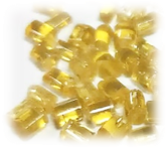Polyetherimide
Thermoplastics > Superpolymers

| Polyetherimide (PEI) | ||||||||
At Mexpolimeros we offer a wide range of polymeric, elastomeric and composite materials developed according to your needs, guaranteeing quality in products and service. Our range of products includes grades without reinforcement, with fiberglass and / or with mineral load (Ibridos), loaded with metals, modified on impact, with special additives such as heat stabilizer, UV, metals, antistatic, antibacterial, laser marking , nucleated etc, special lubricant and flame retardant (with or without halogens). We are also developed and evaluated by highly qualified personnel with advanced technology. |  | |||||||
| Polyetherimide (PEI) | ||||||||
The PEI or Polyetherimide, is a material that offers a high mechanical efficiency in combination with an excellent thermal and chemical resistance. The temperature for continuous use is up to +170 ° C. approximately. It also has a high dimensional stability and resistance to creep. Resistance to irradiation and hydrolysis (medical applications) are also considered very good. The low smoke production, together with its self-extinguishing capacity, have allowed applications in aircraft. Its great resistance to moments of torsion, with respect to thermoplastic materials, allows the economic replacement of small pieces of steel. |  | |||||||
| Symbols | ||||||||
| | |||||||
| PEI properties | ||||||||
| ||||||||
| Products range | ||||||||
| PEI is available in opaque and transparent adaptive colors as well as glass filled products. In addition, PEI copolymers are available even to meet even greater chemical, thermal and elasticity requirements | ||||||||
| Propiedades Mecánicas Físicas PEI | ||||||||
The thermoplastic polyetherimide (PEI) resins offer incredible thermo-resistance, high strength and stiffness and broad chemical resistance. PEI resins have a unique balance between mechanical properties and processability, offering design technicians exceptional freedom and flexibility. It is among the most stable dimensionally stable thermoplastics on the market, offering great predictability over a wide temperature range. Filled products offer exceptionally high tolerance dimensional capacities. PEI is a transparent amber colored polymer, not with great optical qualities. Properties similar to polyetheretherketone (PEEK), but with lower costs. It often replaces polycarbonate when requests for temperature resistance are higher. | ||||||||
| Thermal properties PEI | ||||||||
Excellent stability of the physical and mechanical properties at high temperatures thanks to a glass transition temperature of 217 & 176 ° C, prolonged use at 170 ° C, suitable for high temperature applications thanks to the possibility of withstanding temperatures up to 240 ° C. Available with relative thermal indices (RTI) of up to 180 & 176º C. Resistance to intrinsic flame without additives in most products, exceptionally difficult to ignite, with an oxygen limit index (LOI) of 47%, fulfilling the requirements of the UL94 V0 standard in sections as thin as 0.41 mm. Extremely low smoke generation, with combustion products with a toxicity similar to wood. The PEI retains all its resistance, rigidity and dimensional stability when exposed to the high temperatures of microwave cooking. | ||||||||
| Electricals properties | ||||||||
It absorbs low humidity of 0.7% at 23 ° C / 50% RH and 1.25%, therefore it shows excellent electrical properties, low dissipation factor, high dielectric strength, which remain stable in a wide range of environmental conditions. This stability, combined with excellent thermal properties, make the PEI candidates for demanding electronics applications. It is used in applications in which the material must absorb the minimum possible electrical energy in the form of heat. | ||||||||
| Compliance with PEI standards | ||||||||
| They offer transparency and fluidity for thin wall molding, comply with the regulations of the North American FDA and the EU for contact with food, and are NSF51 certified. The PEI meet the requirements of the European Food Safety Authority (EFSA) and the Japanese Association of Hygienic Plastics based on styrene and olefins (JHOSPA) for contact with food. | ||||||||
| Chemicals resistance | ||||||||
Unlike most amorphous thermoplastics, PEI resins maintain great strength and do not crack when exposed to aircraft and automobile fluids, aliphatic hydrocarbons, alcohols, acids and weak aqueous solutions but have low medium resistance to susceptibility. and cracks of efforts. Good resistance to hydrolysis, suitable for steam sterilization. The PEI supports prolonged exposure to various cleaning agents and food groups without deteriorating, cracking or losing their initial physical properties. Excellent resistance to microwave radiation, approved by the FDA, resistant to prolonged exposure to various cleaning agents and food groups without cracking the surface, cracking or losing physical properties that had just been printed, but can be attacked by halogenated solvents, with the formation of microcracks. It is resistant to UV rays and maintains low smoke emission during combustion. Thanks to its good resistance to hydrolysis, the PEI is able to withstand repeated autoclave cycles. | ||||||||
| Processability | ||||||||
The artifacts in the PEI are generally made by injection molding, extrusion blow molding and can be extruded, thermoformed and subsequently processed with the standard equipment for carpentry and metallurgy without suffering cracks, pitting, breakage of any kind. Its fluidity allows for low flow lengths of only 0.2 mm in thickness, using conventional injection molding equipment | ||||||||
| Welding PEI | ||||||||
| It is advisable to dry the piece first. Once welded with hot gas, it must be annealed. It is better to weld with hot elements, friction or ultrasound. It is highly weldable. | ||||||||
| PEI Engineering Notes | ||||||||
| The resistance to fire and high voltages of the PEI makes it ideal for the clamps used to connect printed circuits to the video screens used in aircraft, tanks and ships. | ||||||||
| PEI polymerization | ||||||||
Derived from the molecule of N-phenyl-4-nitrophthalimide and the disodium salt biphenol A. To obtain it, various condensations and polycondensate fusions are carried out with an aromatic diamine in a ventilated extruder at temperatures between 200 and 290 ° C. The polycondensation is accelerated with the catalyst: NaCl or Fe2 (SO4) 3. | ||||||||
| Applications PEI | ||||||||
PEIs are suitable for a wide variety of applications, such as microwave utensils, cookware, sources to keep food warm, trays for food in catering and industrial and domestic appliances such as coffee dispensers, steam ovens and fryers. Components in electrical engineering, recipients of portions in dentistry, pump casings in the food industry and in aeronautical construction. | ||||||||
